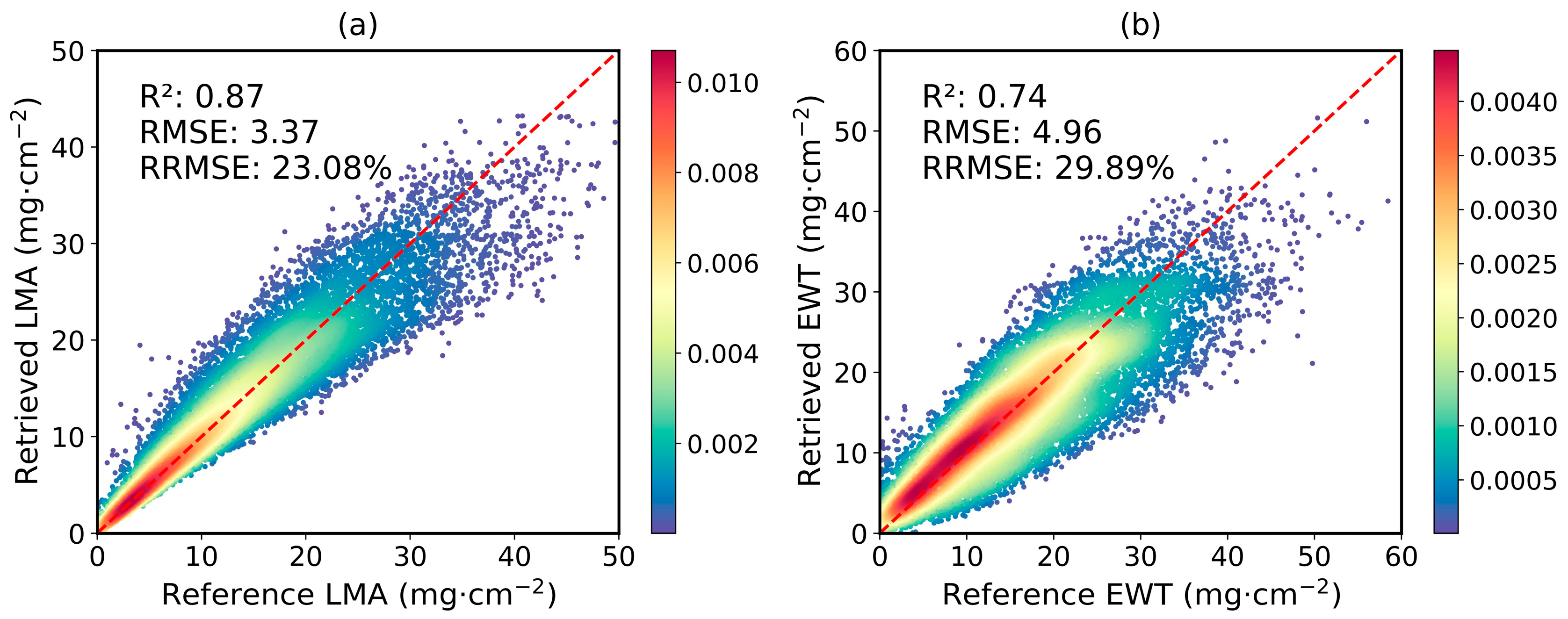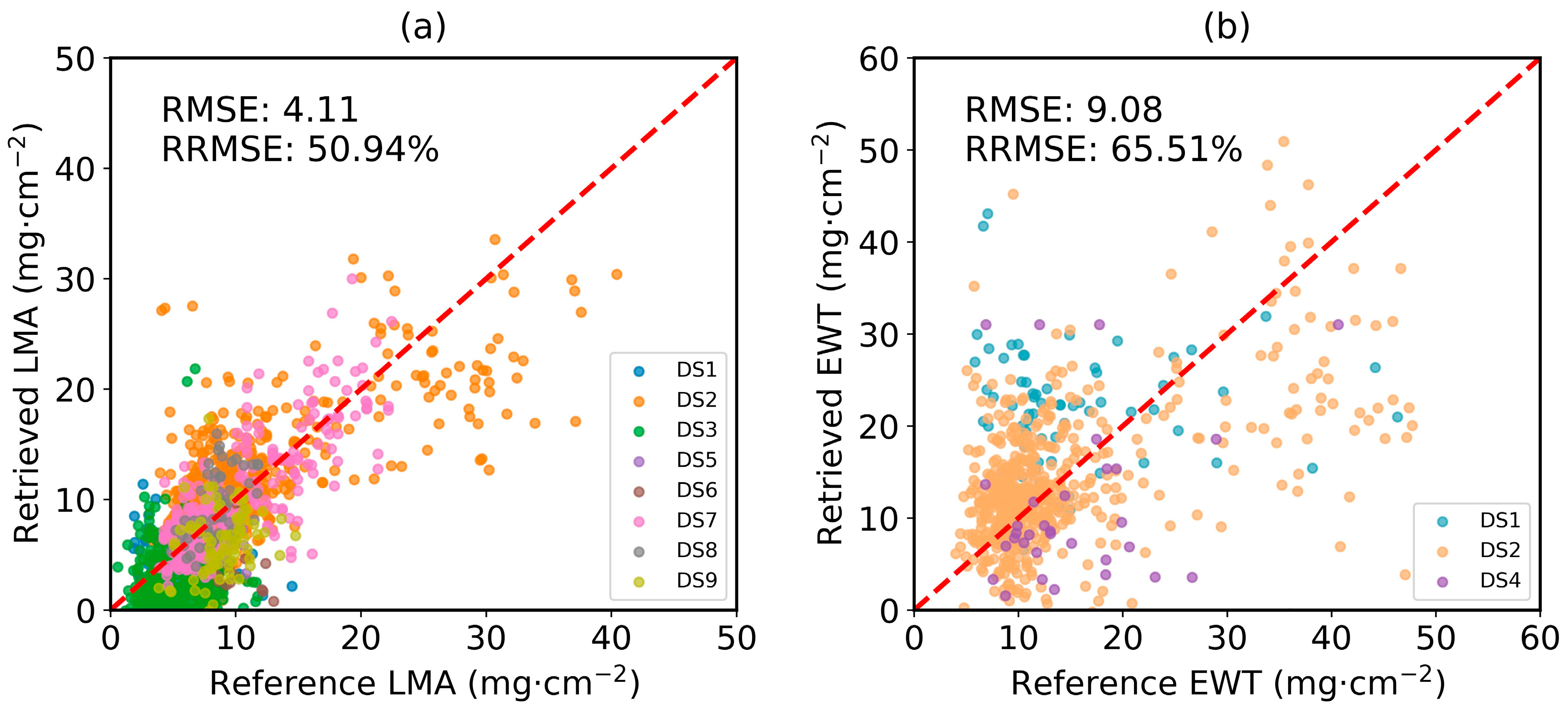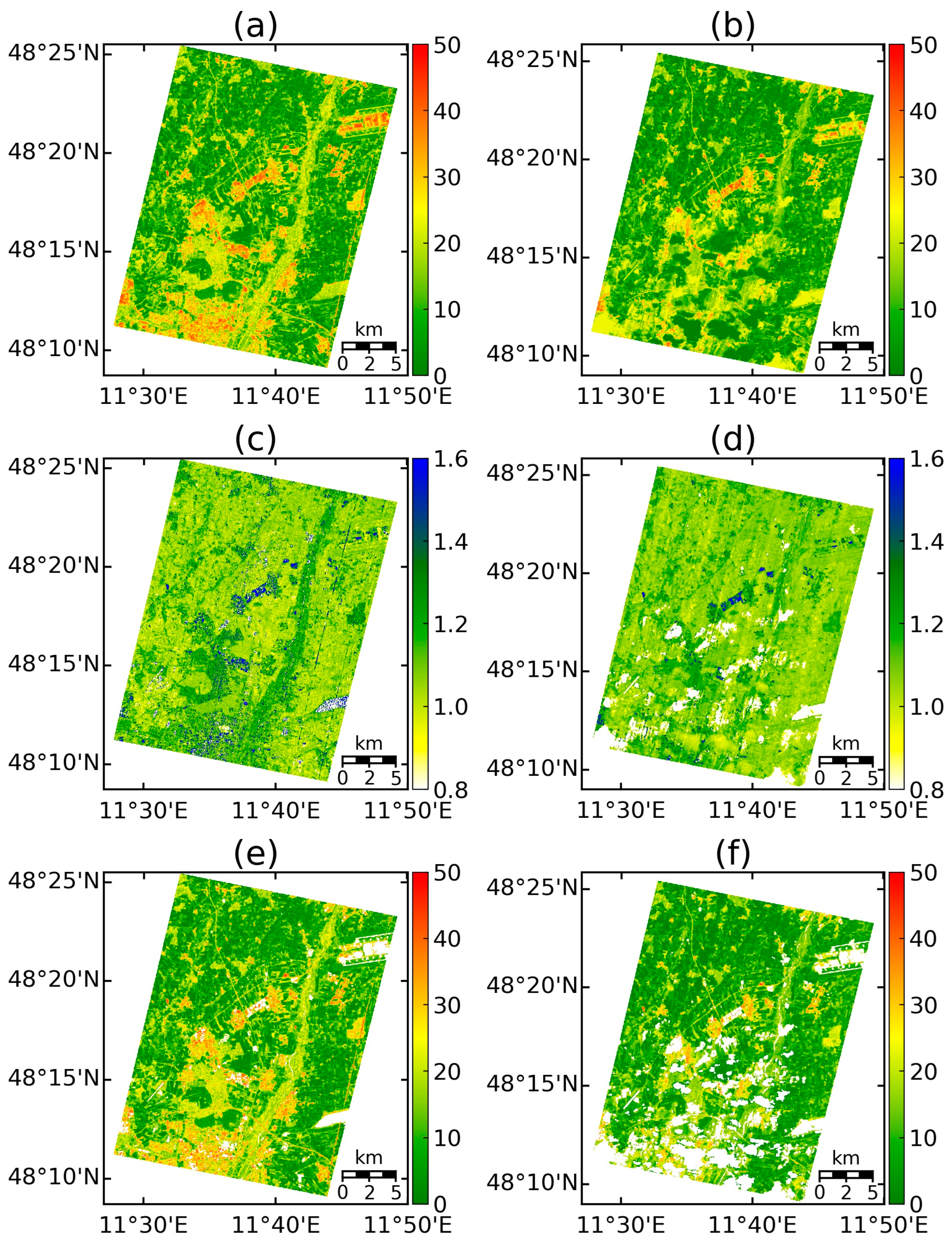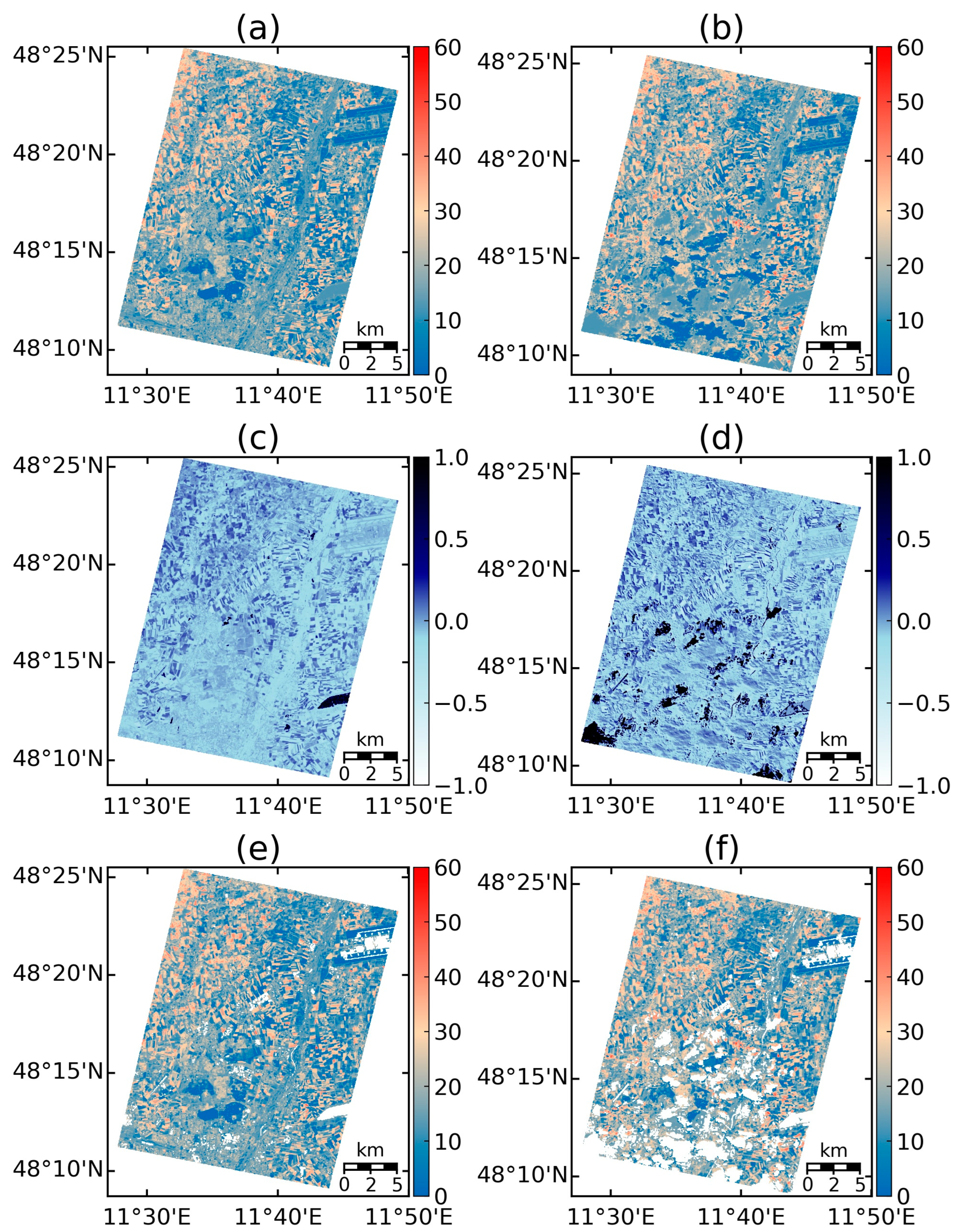Mapping Leaf Mass Per Area and Equivalent Water Thickness from PRISMA and EnMAP
Abstract
:1. Introduction
2. Materials and Methods
2.1. Datasets
2.1.1. Image Spectroscopy
2.1.2. Field Measurements
2.2. LMA and EWT Inversion
2.2.1. Radiative Transfer Modeling
2.2.2. Hybrid Inversion Model
2.2.3. Optimal Spectral Band Analysis
3. Results
3.1. Selection of the Optimal Bands for Hybrid Models
3.2. Assessment on Estimates of LMA and EWT
4. Discussion
4.1. Limitation of Field Datasets and Hyvrid Inverion Models
4.2. Estimation of LMA and EWT from Canopy-Scale Reflectance
4.3. Challenges and Opportunities in Satellite-Based Vegetation Monitoring
5. Conclusions
Author Contributions
Funding
Data Availability Statement
Acknowledgments
Conflicts of Interest
References
- Yi, Q.; Wang, F.; Bao, A.; Jiapaer, G. Leaf and canopy water content estimation in cotton using hyperspectral indices and radiative transfer models. Int. J. Appl. Earth Obs. Geoinf. 2014, 33, 67–75. [Google Scholar] [CrossRef]
- Lavorel, S.; Garnier, E. Predicting changes in community composition and ecosystem functioning from plant traits: Revisiting the Holy Grail. Funct. Ecol. 2002, 16, 545–556. [Google Scholar] [CrossRef]
- Zarco-Tejada, P.J.; Rueda, C.A.; Ustin, S.L. Water content estimation in vegetation with MODIS reflectance data and model inversion methods. Remote Sens. Environ. 2003, 85, 109–124. [Google Scholar] [CrossRef]
- Féret, J.-B.; François, C.; Gitelson, A.; Asner, G.P.; Barry, K.M.; Panigada, C.; Richardson, A.D.; Jacquemoud, S. Optimizing spectral indices and chemometric analysis of leaf chemical properties using radiative transfer modeling. Remote Sens. Environ. 2011, 115, 2742–2750. [Google Scholar] [CrossRef]
- Asner, G.P.; Martin, R.E.; Carranza-Jiménez, L.; Sinca, F.; Tupayachi, R.; Anderson, C.B.; Martinez, P. Functional and biological diversity of foliar spectra in tree canopies throughout the Andes to Amazon region. New Phytol. 2014, 204, 127–139. [Google Scholar] [CrossRef] [PubMed]
- Pereira, H.M.; Ferrier, S.; Walters, M.; Geller, G.N.; Jongman, R.H.G.; Scholes, R.J.; Bruford, M.W.; Brummitt, N.; Butchart, S.H.M.; Cardoso, A.C.; et al. Essential Biodiversity Variables. Science 2013, 339, 277–278. [Google Scholar] [CrossRef]
- Puglielli, G.; Crescente, M.F.; Frattaroli, A.R.; Gratani, L. Leaf mass per area (LMA) as a possible predictor of adaptive strategies in two species of Sesleria (Poaceae): Analysis of morphological, anatomical and physiological leaf traits. Ann. Bot. Fenn. 2015, 52, 135–143. [Google Scholar] [CrossRef]
- Niinemets, Ü.; Kull, O.; Tenhunen, J.D. Variability in Leaf Morphology and Chemical Composition as a Function of Canopy Light Environment in Coexisting Deciduous Trees. Int. J. Plant Sci. 1999, 160, 837–848. [Google Scholar] [CrossRef]
- Asner, G.P.; Martin, R.E.; Tupayachi, R.; Emerson, R.; Martinez, P.; Sinca, F.; Powell, G.V.N.; Wright, S.J.; Lugo, A.E. Taxonomy and remote sensing of leaf mass per area (LMA) in humid tropical forests. Ecol. Appl. 2011, 21, 85–98. [Google Scholar] [CrossRef]
- Wright, I.J.; Reich, P.B.; Westoby, M.; Ackerly, D.D.; Baruch, Z.; Bongers, F.; Cavender-Bares, J.; Chapin, T.; Cornelissen, J.H.C.; Diemer, M.; et al. The worldwide leaf economics spectrum. Nature 2004, 428, 821–827. [Google Scholar] [CrossRef]
- Osnas, J.L.D.; Lichstein, J.W.; Reich, P.B.; Pacala, S.W. Global Leaf Trait Relationships: Mass, Area, and the Leaf Economics Spectrum. Science 2013, 340, 741–744. [Google Scholar] [CrossRef] [PubMed]
- Gara, T.W.; Rahimzadeh-Bajgiran, P.; Darvishzadeh, R. Forest Leaf Mass per Area (LMA) through the Eye of Optical Remote Sensing: A Review and Future Outlook. Remote Sen. 2021, 13, 3352. [Google Scholar] [CrossRef]
- Reich, P.B.; Walters, M.B.; Ellsworth, D.S.; Vose, J.M.; Volin, J.C.; Gresham, C.; Bowman, W.D. Relationships of leaf dark respiration to leaf nitrogen, specific leaf area and leaf life-span: A test across biomes and functional groups. Oecologia 1998, 114, 471–482. [Google Scholar] [CrossRef] [PubMed]
- Weng, E.; Farrior, C.E.; Dybzinski, R.; Pacala, S.W. Predicting Vegetation type through physiological and environmental interactions with leaf traits: Evergreen and deciduous forests in an earth system modeling framework. Glob. Change Biol. 2017, 23, 2482–2498. [Google Scholar] [CrossRef] [PubMed]
- Mcgill, B.; Enquist, B.; Weiher, E.; Westoby, M. Rebuilding community ecology from functional traits. Trends Ecol. Evol. 2006, 21, 178–185. [Google Scholar] [CrossRef]
- Schimel, D.; Pavlick, R.; Fisher, J.B.; Asner, G.P.; Saatchi, S.; Townsend, P.; Miller, C.; Frankenberg, C.; Hibbard, K.; Cox, P. Observing terrestrial ecosystems and the carbon cycle from space. Glob. Change Biol. 2015, 21, 1762–1776. [Google Scholar] [CrossRef]
- Poorter, H.; Niinemets, Ü.; Poorter, L.; Wright, I.J.; Villar, R. Causes and consequences of variation in leaf mass per area (LMA): A meta-analysis. New Phytol. 2009, 182, 565–588. [Google Scholar] [CrossRef]
- Raymond Hunt, E.; Wang, L.; Qu, J.J.; Hao, X. Remote Sensing of fuel moisture content from canopy water indices and normalized dry matter index. J. Appl. Remote Sens. 2012, 6, 061705. [Google Scholar] [CrossRef]
- Wang, L.; Hunt, E.R.; Qu, J.J.; Hao, X.; Daughtry, C.S.T. Remote sensing of fuel moisture content from ratios of narrow-band vegetation water and dry-matter indices. Remote Sens. Environ. 2013, 129, 103–110. [Google Scholar] [CrossRef]
- Zhang, C.; Pattey, E.; Liu, J.; Cai, H.; Shang, J.; Dong, T. Retrieving Leaf and Canopy Water Content of Winter Wheat Using Vegetation Water Indices. IEEE J. Sel. Top. Appl. Earth Obs. Remote Sens. 2018, 11, 112–126. [Google Scholar] [CrossRef]
- Chen, Y.; Sun, J.; Wang, L.; Shi, S.; Qiu, F.; Gong, W.; Wang, S.; Tagesson, T. Exploring the potential of transmittance vegetation indices for leaf functional traits retrieval. GISci. Remote Sens. 2023, 60, 2168410. [Google Scholar] [CrossRef]
- Peñuelas, J.; Filella, I.; Biel, C.; Serrano, L.; Savé, R. The reflectance at the 950–970 nm region as an indicator of plant water status. Int. J. Remote Sens. 1993, 14, 1887–1905. [Google Scholar] [CrossRef]
- Claudio, H.; Cheng, Y.; Fuentes, D.; Gamon, J.; Luo, H.; Oechel, W.; Qiu, H.; Rahman, A.; Sims, D. Monitoring drought effects on vegetation water content and fluxes in chaparral with the 970 nm water band index. Remote Sens. Environ. 2006, 103, 304–311. [Google Scholar] [CrossRef]
- Chuvieco, E.; Cocero, D.; Riaño, D.; Martin, P.; Martínez-Vega, J.; De La Riva, J.; Pérez, F. Combining NDVI and surface temperature for the estimation of live fuel moisture content in forest fire danger rating. Remote Sens. Environ. 2004, 92, 322–331. [Google Scholar] [CrossRef]
- Verrelst, J.; Malenovský, Z.; Van Der Tol, C.; Camps-Valls, G.; Gastellu-Etchegorry, J.-P.; Lewis, P.; North, P.; Moreno, J. Quantifying Vegetation Biophysical Variables from Imaging Spectroscopy Data: A Review on Retrieval Methods. Surv. Geophys. 2019, 40, 589–629. [Google Scholar] [CrossRef]
- Asner, G.P.; Martin, R.E. Airborne spectranomics: Mapping canopy chemical and taxonomic diversity in tropical forests. Front. Ecol. Environ. 2009, 7, 269–276. [Google Scholar] [CrossRef]
- Houborg, R.; Boegh, E. Mapping leaf chlorophyll and leaf area index using inverse and forward canopy reflectance modeling and SPOT reflectance data. Remote Sens. Environ. 2008, 112, 186–202. [Google Scholar] [CrossRef]
- Weiss, M.; Jacob, F.; Duveiller, G. Remote sensing for agricultural applications: A meta-review. Remote Sens. Environ. 2020, 236, 111402. [Google Scholar] [CrossRef]
- Féret, J.-B.; Le Maire, G.; Jay, S.; Berveiller, D.; Bendoula, R.; Hmimina, G.; Cheraiet, A.; Oliveira, J.C.; Ponzoni, F.J.; Solanki, T.; et al. Estimating leaf mass per area and equivalent water thickness based on leaf optical properties: Potential and limitations of physical modeling and machine learning. Remote Sens. Environ. 2019, 231, 110959. [Google Scholar] [CrossRef]
- Wang, L.; Qu, J.J.; Hao, X.; Hunt, E.R. Estimating dry matter content from spectral reflectance for green leaves of different species. Int. J. Remote Sens. 2011, 32, 7097–7109. [Google Scholar] [CrossRef]
- Cheng, T.; Rivard, B.; Sánchez-Azofeifa, A.G.; Féret, J.-B.; Jacquemoud, S.; Ustin, S.L. Deriving leaf mass per area (LMA) from foliar reflectance across a variety of plant species using continuous wavelet analysis. ISPRS J. Photogramm. Remote Sens. 2014, 87, 28–38. [Google Scholar] [CrossRef]
- Ali, A.M.; Darvishzadeh, R.; Skidmore, A.K.; Duren, I.V. Effects of Canopy Structural Variables on Retrieval of Leaf Dry Matter Content and Specific Leaf Area From Remotely Sensed Data. IEEE J. Sel. Top. Appl. Earth Obs. Remote Sens. 2016, 9, 898–909. [Google Scholar] [CrossRef]
- Wan, L.; Tang, Z.; Zhang, J.; Chen, S.; Zhou, W.; Cen, H. Upscaling from Leaf to canopy: Improved spectral indices for leaf biochemical traits estimation by minimizing the difference between leaf adaxial and abaxial surfaces. Field Crops Res. 2021, 274, 108330. [Google Scholar] [CrossRef]
- Gao, B. NDWI—A normalized difference water index for remote sensing of vegetation liquid water from space. Remote Sens. Environ. 1996, 58, 257–266. [Google Scholar] [CrossRef]
- Sims, D.A.; Gamon, J.A. Estimation of vegetation water content and photosynthetic tissue area from spectral reflectance: A comparison of indices based on liquid water and chlorophyll absorption features. Remote Sens. Environ. 2003, 84, 526–537. [Google Scholar] [CrossRef]
- Lemaire, G.; Francois, C.; Soudani, K.; Berveiller, D.; Pontailler, J.; Breda, N.; Genet, H.; Davi, H.; Dufrene, E. Calibration and validation of hyperspectral indices for the estimation of broadleaved forest leaf chlorophyll content, leaf mass per area, leaf area index and leaf canopy biomass. Remote Sens. Environ. 2008, 112, 3846–3864. [Google Scholar] [CrossRef]
- Penuelas, J.; Pinol, J.; Ogaya, R.; Filella, I. Estimation of plant water concentration by the reflectance Water Index WI (R900/R970). Int. J. Remote Sens. 1997, 18, 2869–2875. [Google Scholar] [CrossRef]
- Hauser, L.T.; Féret, J.-B.; An Binh, N.; Van Der Windt, N.; Sil, Â.F.; Timmermans, J.; Soudzilovskaia, N.A.; Van Bodegom, P.M. Towards scalable estimation of plant functional diversity from Sentinel-2: In-situ validation in a heterogeneous (semi-)natural landscape. Remote Sens. Environ. 2021, 262, 112505. [Google Scholar] [CrossRef]
- Campos-Taberner, M.; Moreno-Martínez, Á.; García-Haro, F.; Camps-Valls, G.; Robinson, N.; Kattge, J.; Running, S. Global Estimation of Biophysical Variables from Google Earth Engine Platform. Remote Sens. 2018, 10, 1167. [Google Scholar] [CrossRef]
- Yang, B.; Lin, H.; He, Y. Data-Driven Methods for the Estimation of Leaf Water and Dry Matter Content: Performances, Potential and Limitations. Sensors 2020, 20, 5394. [Google Scholar] [CrossRef]
- Zhang, Y.; Yang, J.; Liu, X.; Du, L.; Shi, S.; Sun, J.; Chen, B. Estimation of Multi-Species Leaf Area Index Based on Chinese GF-1 Satellite Data Using Look-Up Table and Gaussian Process Regression Methods. Sensors 2020, 20, 2460. [Google Scholar] [CrossRef] [PubMed]
- Homolová, L.; Malenovský, Z.; Clevers, J.G.P.W.; García-Santos, G.; Schaepman, M.E. Review of optical-based remote sensing for plant trait mapping. Ecol. Complex. 2013, 15, 1–16. [Google Scholar] [CrossRef]
- Goetz, A.F.H. Three Decades of hyperspectral remote sensing of the earth: A personal view. Remote Sens. Environ. 2009, 113, S5–S16. [Google Scholar] [CrossRef]
- Verrelst, J.; Rivera-Caicedo, J.P.; Reyes-Muñoz, P.; Morata, M.; Amin, E.; Tagliabue, G.; Panigada, C.; Hank, T.; Berger, K. Mapping landscape canopy nitrogen content from space using PRISMA data. ISPRS J. Photogramm. Remote Sens. 2021, 178, 382–395. [Google Scholar] [CrossRef]
- Pascual-Venteo, A.B.; Garcia, J.L.; Berger, K.; Estévez, J.; Vicent, J.; Pérez-Suay, A.; Van Wittenberghe, S.; Verrelst, J. Gaussian Process Regression Hybrid Models for the Top-of-Atmosphere Retrieval of Vegetation Traits Applied to PRISMA and EnMAP Imagery. Remote Sens. 2024, 16, 1211. [Google Scholar] [CrossRef]
- Guanter, L.; Kaufmann, H.; Segl, K.; Foerster, S.; Rogass, C.; Chabrillat, S.; Kuester, T.; Hollstein, A.; Rossner, G.; Chlebek, C.; et al. The EnMAP Spaceborne Imaging Spectroscopy Mission for Earth Observation. Remote Sens. 2015, 7, 8830–8857. [Google Scholar] [CrossRef]
- Labate, D.; Ceccherini, M.; Cisbani, A.; De Cosmo, V.; Galeazzi, C.; Giunti, L.; Melozzi, M.; Pieraccini, S.; Stagi, M. The PRISMA payload optomechanical design, a high performance instrument for a new hyperspectral mission. Acta Astronaut. 2009, 65, 1429–1436. [Google Scholar] [CrossRef]
- Van Cleemput, E.; Helsen, K.; Feilhauer, H.; Honnay, H.; Somers, B. Canopy Spectra of Individual Herbaceous Species Measured on Black Table. From the Ecological Spectral Information System (EcoSIS). Available online: http://ecosis.org/package/canopy-spectra-of-individual-herbaceous-species-measured-on-black-table (accessed on 17 October 2024). [CrossRef]
- Wang, Z. Canopy Spectra to Map Foliar Functional Traits over NEON Domains in Eastern United States. The Ecological Spectral Information System (EcoSIS). Available online: http://ecosis.org/package/canopy-spectra-to-map-foliar-functional-traits-over-neon-domains-in-eastern-united-states (accessed on 17 October 2024). [CrossRef]
- Kattenborn, T.; Schiefer, F.; Schmidtlein, S. Canopy Reflectance Plant Functional Gradient IFGG/KIT. The Ecological Spectral Information System (EcoSIS). Available online: http://ecosis.org/package/canopy-reflectance-plant-functional-gradient-ifgg-kit (accessed on 17 October 2024). [CrossRef]
- Shawn, P.S.; Daryl, Y.; Ran, M.; Andrew, M.; Wouter, H.; Daniel, H.; Kim, E. NGEE Arctic 2017 Canopy Spectral Reflectance Seward Peninsula Alaska. The Ecological Spectral Information System (EcoSIS). Available online: http://ecosis.org/package/ngee-arctic-2017-canopy-spectral-reflectance-seward-peninsula-alaska (accessed on 17 October 2024).
- Shawn, P.S.; Alistair, R.; Kim, E. NGEE Arctic 2016 Averaged Canopy Spectral Reflectance Seward Peninsula Alaska. The Ecological Spectral Information System (EcoSIS). Available online: http://ecosis.org/package/ngee-arctic-2016-averaged-canopy-spectral-reflectance-seward-peninsula-alaska (accessed on 17 October 2024).
- Shawn, P.S.; Daryl, Y.; Ran, M.; Andrew, M.; Wouter, H.; Daniel, H.; Kim, E. NGEE Arctic 2018 Canopy Spectral Reflectance Kougarok Watershed Seward Peninsula Alaska. The Ecological Spectral Information System (EcoSIS). Available online: http://ecosis.org/package/ngee-arctic-2018-canopy-spectral-reflectance-kougarok-watershed-seward-peninsula-alaska (accessed on 17 October 2024).
- Singh, A. Mapping Canopy Foliar Chemical and Morphological Traits Using Imaging Spectroscopy. The Ecological Spectral Information System (EcoSIS). Available online: http://ecosis.org/package/mapping-canopy-foliar-chemical-and-morphological-traits-using-imaging-spectroscopy (accessed on 17 October 2024).
- Chlus, A. 3D LMA Canopy Level Spectra. The Ecological Spectral Information System (EcoSIS). Available online: http://ecosis.org/package/3d-lma-canopy-level-spectra (accessed on 17 October 2024).
- Philip, A.T.; Chlus, A. Seasonal Canopy Spectra and Traits, Blackhawk Island, WI. The Ecological Spectral Information System (EcoSIS). Available online: http://ecosis.org/package/seasonal-canopy-spectra-and-traits--blackhawk-island--wi (accessed on 17 October 2024).
- Féret, J.-B.; Gitelson, A.A.; Noble, S.D.; Jacquemoud, S. PROSPECT-D: Towards modeling leaf optical properties through a complete lifecycle. Remote Sens. Environ. 2017, 193, 204–215. [Google Scholar] [CrossRef]
- Verhoef, W. Light Scattering by Leaf Layers with Application to Canopy Reflectance Modeling: The SAIL Model. Remote Sens. Environ. 1984, 16, 125–141. [Google Scholar] [CrossRef]
- Jacquemoud, S.; Verhoef, W.; Baret, F.; Bacour, C.; Zarco-Tejada, P.J.; Asner, G.P.; François, C.; Ustin, S.L. PROSPECT+SAIL models: A review of use for vegetation characterization. Remote Sens. Environ. 2009, 113, S56–S66. [Google Scholar] [CrossRef]
- Combal, B.; Baret, F.; Weiss, M.; Trubuil, A.; Macé, D.; Pragnère, A.; Myneni, R.; Knyazikhin, Y.; Wang, L. Retrieval of canopy biophysical variables from bidirectional reflectance. Remote Sens. Environ. 2003, 84, 1–15. [Google Scholar] [CrossRef]
- Baskiotis, C.; Aval, J.; Bouz, M.E.; Falou, A.A. Selecting Hyperspectral Bands for Leaf Mass Per Area Prediction by Means of Neural Networks. In Proceedings of the IEEE International Symposium on Geoscience and Remote Sensing (IGARSS), Kuala Lumpur, Malaysia, 17–22 July 2022; pp. 1408–1411. [Google Scholar] [CrossRef]
- Weiss, M.; Baret, F.; Garrigues, S.; Lacaze, R. LAI and fAPAR CYCLOPES global products derived from VEGETATION. Part 2: Validation and comparison with MODIS collection 4 Products. Remote Sens. Environ. 2007, 110, 317–331. [Google Scholar] [CrossRef]
- Cherif, E.; Feilhauer, H.; Berger, K.; Dao, P.D.; Ewald, M.; Hank, T.B.; He, Y.; Kovach, K.R.; Lu, B.; Townsend, P.A.; et al. From spectra to plant functional traits: Transferable multi-trait models from heterogeneous and sparse data. Remote Sens. Environ. 2023, 292, 113580. [Google Scholar] [CrossRef]
- Asner, G.; Martin, R. Spectral and chemical analysis of tropical forests: Scaling from leaf to canopy levels. Remote Sens. Environ. 2008, 112, 3958–3970. [Google Scholar] [CrossRef]
- Riggs, G.A.; Running, S.W. Detection of canopy water stress in conifers using the airborne imaging spectrometer. Remote Sens. Environ. 1991, 35, 51–68. [Google Scholar] [CrossRef]
- Yebra, M.; Dennison, P.E.; Chuvieco, E.; Riaño, D.; Zylstra, P.; Hunt, E.R.; Danson, F.M.; Qi, Y.; Jurdao, S. A global review of remote sensing of live fuel moisture content for fire danger assessment: Moving towards operational products. Remote Sens. Environ. 2013, 136, 455–468. [Google Scholar] [CrossRef]







| Dataset | Traits | Min | Max | Method | Spectra Range | NB | Land Cover | NS | Reference |
|---|---|---|---|---|---|---|---|---|---|
| DS1 | LMA | 1.82 | 14.49 | Proximal | 350–2500 | 2151 | Grassland | 73 | [48] |
| EWT | 5.81 | 46.31 | 73 | ||||||
| DS2 | LMA | 3.39 | 50.71 | Airborne | 384–2512 | 426 | Mix | 666 | [49] |
| EWT | 3.97 | 80.62 | 648 | ||||||
| DS3 | LMA | 0.57 | 11.75 | Proximal | 400–2500 | 2101 | Grassland | 582 | [50] |
| DS4 | EWT | 4.05 | 40.65 | Proximal | 350–2500 | 2151 | Tundra | 43 | [51] |
| DS5 | LMA | 5.59 | 10.82 | Proximal | 350–2500 | 2151 | Tundra | 18 | [52] |
| DS6 | LMA | 8.32 | 13.02 | Proximal | 350–2500 | 2151 | Shrubland | 22 | [53] |
| DS7 | LMA | 3.92 | 22.43 | Airborne | 366–2500 | 223 | Forests | 304 | [54] |
| DS8 | LMA | 4.83 | 11.77 | Airborne | 405–2445 | 351 | Forests | 59 | [55] |
| DS9 | LMA | 3.84 | 14.77 | Airborne | 407–2389 | 187 | Forests | 80 | [56] |
| Parameter | Description | Unit | Min | Max | Mean | STD | Distribution |
|---|---|---|---|---|---|---|---|
| LMA | Leaf mass per area | mg·cm−2 | 0 | 50 | 10 | 13 | Gaussian |
| EWT | Leaf equivalent water thickness | mg·cm−2 | 0 | 60 | 15 | 11.5 | Gaussian |
| N | Leaf structure parameter | – | 1 | 3 | 1.5 | 1 | Gaussian |
| LAI | Leaf area index | m2·m−2 | 1 | 7 | – | – | Uniform |
| ALIA | Average leaf inclination angle | degree | 30 | 70 | – | – | Uniform |
| Psoil | Soil parameter | – | 0 | 1 | – | – | Uniform |
| SZA | Solar zenith angle | degree | 20 | 60 | – | – | Uniform |
| Traits | Index | Formulation | R2 | RMSE (mg·cm−2) |
|---|---|---|---|---|
| LMA | ARDSI2200,1640,2240,1720 | (R2200 − R1640)/(R2240 − R1720) | 0.67 | 5.4 |
| NDMI | (R1649 − R1722)/(R1649 + R1722) | 0.55 | 6.3 | |
| Band | R2300; R1722; R2133; R1649; R1675; R2281; R2260 | 0.88 | 3.4 | |
| Band | R2300; R1722; R2133; R1649; R2281 | 0.87 | 3.4 | |
| EWT | ARDSI1360,1080,1560,1240 | (R1360 − R1080)/(R1560 − R1240) | 0.64 | 5.7 |
| NDWI | (R860 − R1240)/(R860 + R1240) | 0.46 | 7.0 | |
| Band | R1080; R1240; R1560 | 0.74 | 5.0 |
Disclaimer/Publisher’s Note: The statements, opinions and data contained in all publications are solely those of the individual author(s) and contributor(s) and not of MDPI and/or the editor(s). MDPI and/or the editor(s) disclaim responsibility for any injury to people or property resulting from any ideas, methods, instructions or products referred to in the content. |
© 2024 by the authors. Licensee MDPI, Basel, Switzerland. This article is an open access article distributed under the terms and conditions of the Creative Commons Attribution (CC BY) license (https://creativecommons.org/licenses/by/4.0/).
Share and Cite
Yang, X.; Shi, H.; Xiao, Z. Mapping Leaf Mass Per Area and Equivalent Water Thickness from PRISMA and EnMAP. Remote Sens. 2024, 16, 4064. https://doi.org/10.3390/rs16214064
Yang X, Shi H, Xiao Z. Mapping Leaf Mass Per Area and Equivalent Water Thickness from PRISMA and EnMAP. Remote Sensing. 2024; 16(21):4064. https://doi.org/10.3390/rs16214064
Chicago/Turabian StyleYang, Xi, Hanyu Shi, and Zhiqiang Xiao. 2024. "Mapping Leaf Mass Per Area and Equivalent Water Thickness from PRISMA and EnMAP" Remote Sensing 16, no. 21: 4064. https://doi.org/10.3390/rs16214064
APA StyleYang, X., Shi, H., & Xiao, Z. (2024). Mapping Leaf Mass Per Area and Equivalent Water Thickness from PRISMA and EnMAP. Remote Sensing, 16(21), 4064. https://doi.org/10.3390/rs16214064






